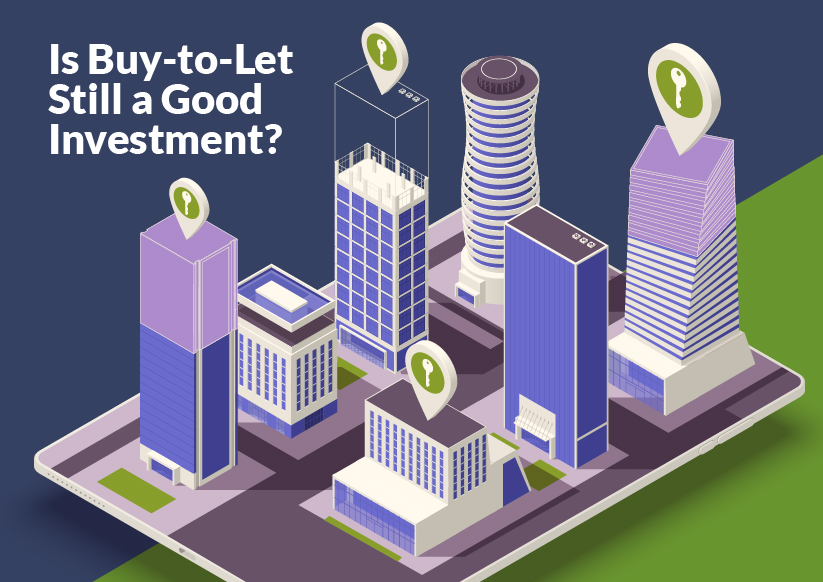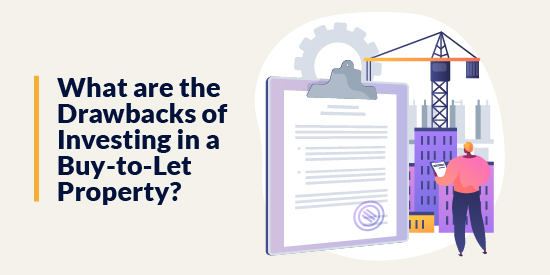Is Buy to Let Worth It? 2024 UK Guide

Are you wondering – Is buy to let worth it? There are plenty of positives to consider: ongoing monthly rental income, capital gains when you come to sell, and a relatively safe and reliable place to invest your money compared to other investment avenues.
Although buy-to-let investors have been affected by recent tax changes, buy-to-rent continues to be a widespread investment strategy. The UK housing market provides numerous opportunities to those who know its regions and the top strategies to maximize profits. Furthermore, the housing market remains robust, and there will always be a steady stream of individuals in need of rental homes.
To determine whether buy-to-let is a worthwhile investment strategy for you, this article evaluates the pros and cons and the essential factors that investors must consider.
Why Invest in Buy-to-Let?
When posed with the question of whether buy-to-let is still a profitable investment, examining prior and current trends can yield insight into the future of the market. Reflecting on the past twenty years, England’s private rental sector experienced substantial growth, with figures more than doubling.
However, the market has recently experienced a slight decrease, with around 4.4 million households privately renting in 2020, a minor decline from 4.5 million in the previous year. This slowdown is also observed with the number of buy-to-let mortgages obtained, particularly in recent months due to high interest rates.
Although these trends have been seen nationwide, London and Yorkshire witnessed an increase in the proportion of houses in the private rental sector since 2019. Despite the slowdown, it is still apparent why buy-to-let property continues to be a favored investment strategy. In the 1980s, the average property price was roughly £23,000 and now sits at £294,000. Although it is improbable that such immense growth will repeat, ongoing demand for rental property persists.
Many cities in the north of England are currently experiencing strong house price growth due to incoming investment and regeneration, making buy-to-let opportunities in Northern cities quite attractive to investors. At the same time, the high property prices mean that the rental market among young professionals – those not yet in a position to buy their own property – is particularly thriving, giving landlords a reliable and ongoing rental demographic.
Is Investing in Buy-to-Let Property Still Worth It?
Before deciding if a UK buy-to-let property is a good investment, assessing your investment goals is important. Buying a property to rent out can be a significant financial commitment, and it’s essential to consider your objectives before moving forward. For instance, are you looking for a stable monthly rental income, capital appreciation, or both?
It’s worth noting that investing in buy-to-let property may not be suitable for everyone. You’ll need to have a substantial deposit saved up, typically around 25% of the property price, which can be a challenge with today’s high house prices. Ensuring that property investing aligns with your risk tolerance, financial goals, and investment strategy is crucial.
It’s also important to compare the advantages and drawbacks of property investment compared to other avenues like cash ISA accounts or investing in the stock market. For example, unlike with stocks, property is not an asset you can quickly get your money out of. At the same time, the amount of money you have to invest may change your strategy and thinking. You can read more about investment strategies and potential returns in our guides: How to Get the Best Return on a £50,000 Investment and The Best Way to Invest 100k.
What are the Benefits of Investing in a Buy-to-Let Property?
When it comes to investment strategy, there are many benefits of buy-to-let:
Ongoing Monthly Income
One key benefit of investing in a buy-to-let property is the opportunity to generate a regular monthly income from rental payments. This can be especially attractive for those looking to supplement their existing income or build a passive income stream.
If you’re able to find the right property with decent rental yields, it’s possible for the rental income to cover not only the mortgage payments but also repairs and maintenance costs. This means that the property can essentially pay for itself, with the added benefit of generating a profit for the investor.
The rental yield of a property can vary depending on a number of factors, including the property type, location and market conditions. While the average rental yield in the UK is around 5%, there are certain areas where rental yields can be as high as 8-10%. It’s important for investors to do their research and carefully consider these factors before making a decision about which property to invest in.
Capital Growth
Investing in buy-to-let properties can be a smart financial decision as it allows you to generate ongoing monthly income and a lump sum profit when you sell the property. One of the advantages of investing in property is that, over time, the value of the property may increase, providing you with capital growth.
This can be a significant advantage for buy-to-let investors, as it means that you can generate income by renting the property and potentially sell it for a higher price than what you initially paid for it.
Safe Long-Term Investment
Property investment is often considered a good option for those who are looking for a long-term investment with the potential to generate a profit. While the property market can be subject to fluctuations, the value of property tends to increase over time, making it a relatively safe investment option compared to others.
When investing in property, it’s important to remember that it can take time to see a return on your investment. However, you can offset this by the fact that you are generating ongoing rental income from tenants. As well as the potential for a lump sum profit when you come to sell the property.
Overall, property investment can offer a safe and reliable way to generate a profit over the long-term. While there are risks involved, such as fluctuations in the property market or periods of low occupancy, investing in property can be a solid strategy for those looking for a reliable investment option.
What are the Drawbacks of Investing in a Buy-to-Let Property?

A key hurdle landlords face today is a more challenging tax environment than in previous years, with the need to factor in the costs of stamp duty, insurance, wear and tear and other costs to ensure their property remains profitable.
Stamp Duty
Since 2016 there has been an additional 3% stamp duty tax to pay for anyone buying a second property (find out more information about buying a second home, or some of the ways to avoid stamp duty on a second home in these articles. )
Previously, landlords benefited from being allowed to offset 10% of their annual rental income against tax for wear and tear of their property and mortgage interest relief meant that landlords could offset mortgage interest costs against income tax bills on rent. Today, with the additional stamp duty and removal of mortgage interest relief, profits on an investment property are being squeezed.
Capital Gains Tax
When it comes to selling, capital gains tax on residential property is higher than other investments. Capital gains tax on a residential property is 28% for upper taxpayer brackets and 18% for basic tax rate payers; in contrast, on other assets, it’s 18% and 10%, respectively, which can eat into the potential profits a property offers. For property investors growing a portfolio, one way to mitigate the impact of these tax changes is to invest through a limited company, which still gives you access to mortgage interest relief to reduce your tax bill. This setup is more beneficial to higher rate taxpayers and those with multiple properties.
Time and Risk
When embarking on a buy-to-let investment, potential landlords need to be aware of the time they will need to spend researching the market, buying rental property and managing the property, including dealing with tenants and handling repairs.
The buying process can sometimes be lengthy, and if you manage a property yourself without a property management company, there may be a lot of work to undertake. Similarly, property markets fluctuate, and if the market drops, your property prices fall, reducing your capital. You’ll also need to consider factors like void periods in between tenancies and rental arrears, which can increase the risk.
Repairs and General Costs
As a landlord, it is essential to adhere to a range of legal obligations and regulations to ensure the safety and well-being of your tenants. One of the primary obligations is obtaining an energy performance certificate (EPC), which is a legal requirement for all rental properties in the UK. An EPC rates a property’s energy efficiency from A to G and outlines measures that you can take to improve energy efficiency.
In addition to these legal requirements, landlords must also maintain their property to a reasonable standard, promptly address any repairs or maintenance issues, and ensure that the property is secure and adequately insured.

Market Trends and Economic Factors
The landscape of the buy-to-let market in the UK in 2024 continues to evolve under the influence of various market trends and economic factors. Understanding these elements is crucial for anyone considering diving into or expanding their footprint in the buy-to-let sector. Here’s a deeper look into how these dynamics play out in the current market.
Current Housing Market Trends Affecting Buy-to-Let Investments
- Shift Towards Remote Working: The enduring trend of remote work has shifted demand from urban centers to more suburban and rural areas, impacting rental yields in different regions. Investors are now looking beyond major cities for properties that offer more space and a better environment for those working from home.
- Supply and Demand Dynamics: There’s an ongoing tightness in housing supply across the UK, which, coupled with a steady demand for rental properties, has led to an increase in rental prices in many areas. This scenario presents a potentially lucrative opportunity for buy-to-let investors, although it also underscores the importance of strategic property selection.
- Energy Efficiency Regulations: The government’s increased focus on energy efficiency in rental properties, with the introduction of higher energy performance certificate (EPC) requirements, is influencing investor decisions. Properties that already meet these requirements or can be easily upgraded are becoming more attractive investments.
Impact of Economic Factors on the Buy-to-Let Market
- Interest Rates: The Bank of England’s stance on interest rates significantly affects the cost of borrowing for buy-to-let mortgages. As of 2024, any fluctuations in interest rates will directly impact investors’ profit margins, making it a critical factor to watch.
- Inflation: Inflation rates influence the overall cost of living and, consequently, the amount of rent tenants can afford. High inflation can squeeze renters’ budgets but also allows landlords to adjust rents accordingly, provided the market supports this.
- Unemployment Rates: The health of the job market plays a crucial role in the demand for rental properties. Regions with lower unemployment rates tend to have higher demand for rentals, as stable employment supports tenants’ ability to pay rent.
Analysis of Demand for Rental Properties in Different Regions of the UK
- Regional Variations: The demand for rental properties varies significantly across the UK, with certain regions experiencing higher growth due to factors like local job opportunities, university presence, and lifestyle attractions.
- Urban vs. Rural: Urban areas, especially those with universities and colleges, maintain a consistent demand due to the student population. Conversely, the popularity of rural areas has risen among those seeking more space and a quieter lifestyle, especially if remote work is a viable option.
- Investment Hotspots: Identifying regions that are currently underpriced but poised for future growth due to planned infrastructure projects or economic development initiatives can offer excellent opportunities for buy-to-let investments.
Legislative Changes and Tax Considerations
The buy-to-let market in the UK has undergone significant changes due to recent legislative adjustments and evolving tax considerations. These shifts are reshaping the landscape for landlords and investors, impacting their strategies and profitability. A comprehensive understanding of these changes is essential for anyone involved in or entering the buy-to-let sector.
Summary of Recent Legislative Changes Affecting Landlords
- Tax Relief Changes: One of the most impactful changes has been the phasing out of mortgage interest tax relief for landlords. Previously, landlords could deduct mortgage interest payments from their rental income before calculating their tax liability. However, this has been replaced with a tax credit, capped at the basic tax rate, which could result in higher tax bills for those in higher income brackets.
- Tenant Protection Laws: Recent years have seen a strengthening of tenant rights and protections. This includes more stringent requirements for landlords around the safety and maintenance of properties, such as electrical safety standards and the Homes (Fitness for Human Habitation) Act. Additionally, there have been changes to eviction procedures, making it more challenging to evict tenants without due cause.
- Energy Efficiency Requirements: The government has introduced higher energy efficiency standards for rental properties, requiring them to have a minimum EPC rating. These measures aim to improve the living conditions and reduce the environmental impact of rental properties, but they also necessitate additional investment from landlords to ensure their properties comply.
Tax Considerations for Buy-to-Let Investors
- Stamp Duty: Buy-to-let investors must pay Stamp Duty Land Tax (SDLT) on property purchases, which includes a higher rate for additional properties. This can significantly increase the upfront cost of acquiring a buy-to-let property, affecting the overall return on investment.
- Capital Gains Tax: When selling a rental property, landlords are subject to Capital Gains Tax (CGT) on any profit made above the annual exempt amount. The rate of CGT depends on the individual’s income tax band, and planning for this tax can influence decisions about when to sell a property.
Implications of These Changes for Profitability and Investment Strategy
- Profitability: The combination of reduced tax relief, increased stamp duty, and stricter regulations can squeeze landlords’ profit margins. It becomes crucial for investors to carefully assess the net yield of property investments, considering all expenses and tax obligations.
- Investment Strategy: Investors may need to adapt their strategies in response to these changes. This could involve focusing on properties in areas with high rental demand and potential for capital appreciation, investing in energy-efficient properties to minimize upgrade costs, or considering corporate letting arrangements to diversify income streams.
- Long-Term Planning: The evolving legislative and tax landscape underscores the importance of long-term planning and flexibility in investment strategies. Landlords may need to consider their properties’ longer-term growth potential and the rental market’s changing dynamics to ensure sustained profitability.
Alternatives to Buy-to-Let Investments
While buy-to-let properties have been a popular investment choice for many, there are several other investment opportunities that can diversify an investor’s portfolio and potentially offer different risk-reward profiles. Here’s an overview of some notable alternatives:
Real Estate Investment Trusts (REITs)
REITs allow investors to put their money into a diversified portfolio of real estate assets, which may include commercial properties, residential units, and other types of real estate. REITs are traded on stock exchanges, offering liquidity and ease of entry or exit.
Pros:
- Provides exposure to real estate without the need for direct property management.
- Higher liquidity compared to physical real estate investments.
- Often offers dividends, providing a regular income stream.
Cons:
- Investors have limited control over investment choices.
- Market volatility can affect investment value.
Stocks
Investing in the stock market can offer high returns, with the opportunity to invest in a wide range of sectors. Stocks can range from stable, well-established companies to high-growth startups.
Pros:
- Potential for high returns.
- High liquidity, allowing for quick buying and selling.
- Dividends provide an income stream similar to rental income.
Cons:
- Market volatility can lead to significant losses.
- Requires knowledge and research to select the right stocks.
Bonds
Bonds are considered a safer investment compared to stocks and real estate. When you buy a bond, you’re essentially lending money to the issuer (a corporation or government) in exchange for periodic interest payments and the return of the bond’s face value at maturity.
Pros:
- Stable and predictable income through interest payments.
- Generally lower risk than stocks or real estate.
Cons:
- Lower returns compared to more aggressive investment options.
- Interest rate changes can affect bond prices.
Is Buying-to-Let Still a Good Investment?
While some drawbacks and many responsibilities come with being a landlord, there are ways to help make your investment as profitable as possible from the offset, which makes buy-to-let still a good investment.
One thing to consider is the rental income and property type. Landlords may have a single-let property that they rent out to one person or family. However, an HMO – House of Multiple Occupations – is a property that you rent out to more than one tenant, each with its own contract, such as in a shared student accommodation.
While a single let is more straightforward to manage, an HMO will generally bring in higher monthly rent. The monthly income tax on HMO rental income will be higher, but generally, landlords will make more money. However, HMOs can be harder to fill if the market changes or the property isn’t purchased in the right area. It’s important that landlords weigh up the pros and cons and decide which type of property is right for them.
Another thing to consider is making sure that the property offers a good rental yield. Rental yield is the percentage of return you make back on the purchase price of a property each month.
While the capital gains from selling a property create a nice return, the ongoing rental income is part of the major appeal of purchasing a buy-to-let property. A good rental yield in the UK is around 5%—7% gross.
Ensure you take off ongoing expenses such as tax and maintenance costs to get a clear picture of the expected rental yield. To get the best rental yields, landlords should try to find the sweet spot of low property prices while getting a high rental income from tenants.
Can You Get Rich from Buy-to-Let?
The changes to tax regulations have certainly had an impact on the buy-to-let market, but that doesn’t mean that investing in rental properties is no longer a viable option. While the stamp duty surcharge and changes to mortgage relief have made it more expensive to invest in property, the market is still attractive to investors.
Despite the challenges posed by tax changes and regulations, savvy investors still have opportunities to make a profit in the buy-to-let market. With the right knowledge of the market and an understanding of up-and-coming areas that offer value, low property prices and high rental yields, investors can still generate income from rental properties.
In particular, cities in the north of England are proving to be a lucrative area for buy-to-let investors. Low property prices and high rental demand create favourable conditions for profit. With the right approach, investors can still benefit from the advantages of a buy-to-let investment strategy.
Conclusion
So is buy-to-let still a worthwhile investment? We think yes, and for investors willing to take the time to explore the market, build the right investment strategy and avoid common pitfalls, it can still be lucrative. To find out more about investing in a buy-to-let property or about the markets that will offer the most opportunity in the coming years, get in touch with our team.


